CHEESE & WINE ALLIANCE
Joostenberg & Dalewood: A tale of two family farms
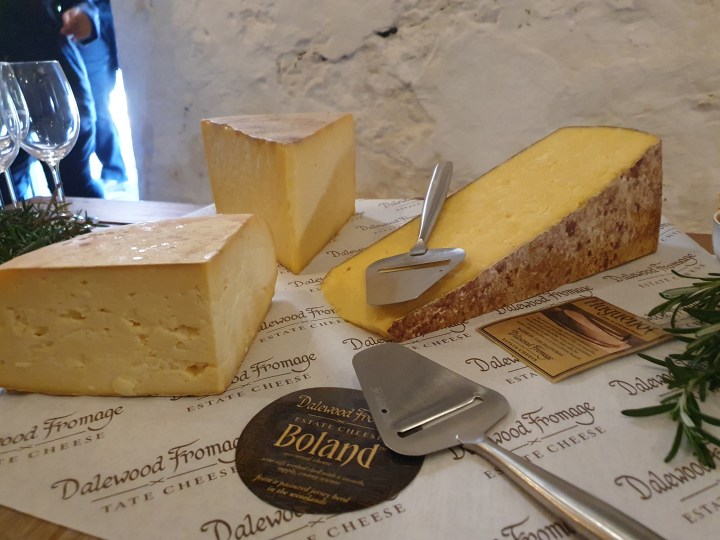
A collaborative lunch at The Kraal at Joostenberg, starring cheeses from neighbouring Dalewood Fromage, provides the perfect platform to talk about (and taste) regenerative farming in action.
Tucking into a gloriously oozy and perfectly ripe soft cheese, the last thing that is usually on my mind is soil structure. Except that today we’re in the barrel cellar at Joostenberg Wine Estate, eyeing up a table piled high with a cornucopia of rather glorious cheeses from Dalewood Fromage, a glass of Joostenberg Fairhead wine in hand, and regenerative farming is the topic of conversation.
“Dalewood and Joostenberg have quite a bit in common,” says Tyrrel Myburgh, the winemaker and fifth-generation farmer at Joostenberg, as he introduces the Visser family of Dalewood. “Rob [Visser, of Dalewood] and I both have strong focus on the environment and trying to improve our soils, doing it with the belief that, if we get that right, he’s going to have better cheeses and I’m going to have better grapes to make wine.”
Joostenberg Wine Estate has been certified as organic for the last 11 harvests, but Myburgh has started going way beyond ticking the boxes required for that certification.
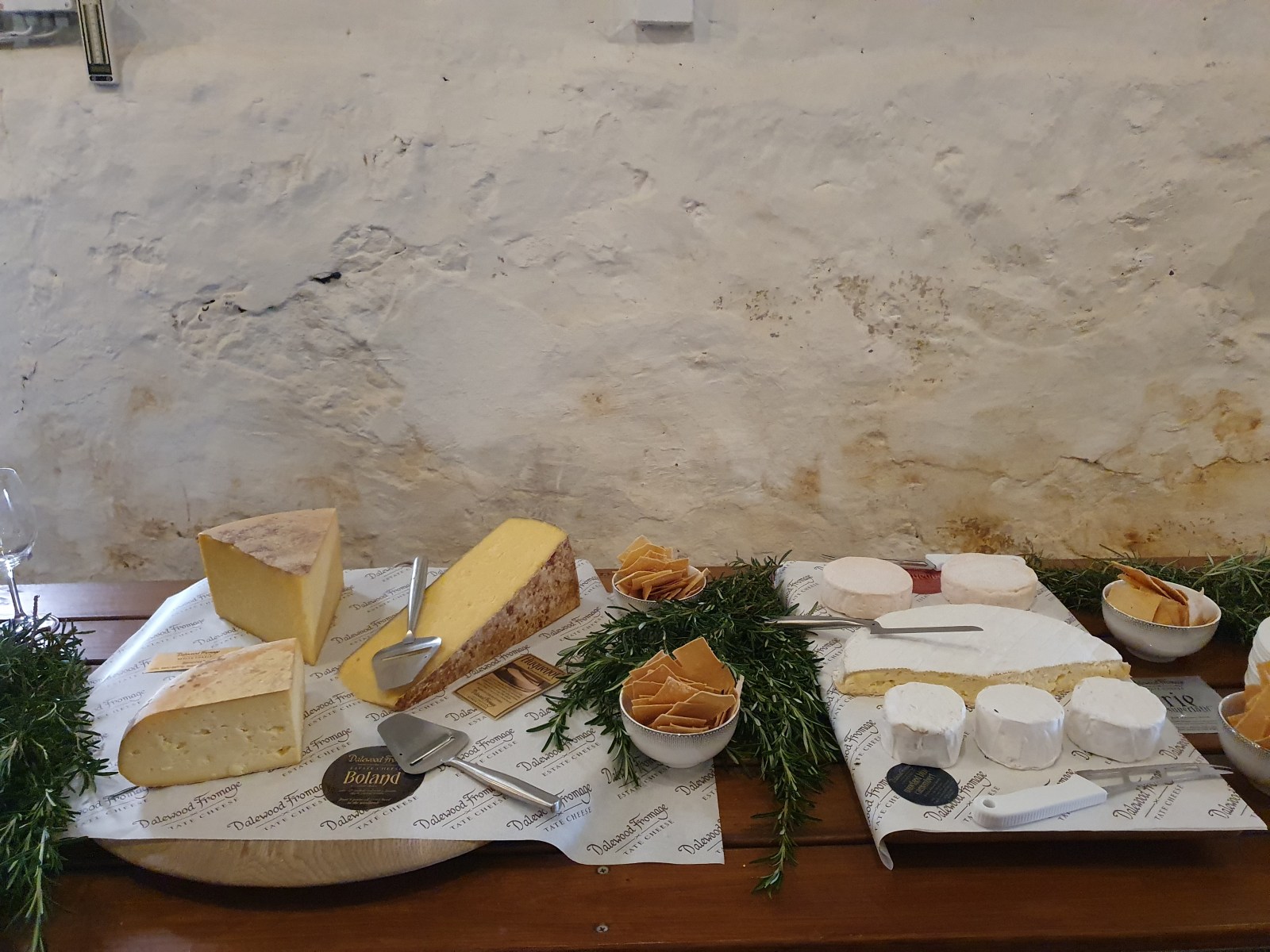
Artisanal single origin estate cheeses from Dalewood’s pasture-fed Jersey herd: mature brushed rind Huguenot and semi-hard Boland, then the gloriously oozy soft washed-rind Lanquedoc and Brie Superlatif. (Photo: Kit Heathcock)
“The last two years we’ve brought in more practices on the regenerative side of farming — we’ve been getting animals into our vineyards in winter. The manure they leave kickstarts the biological processes in the soil, so we don’t have to truck in compost. We’re planting rows of vegetation along our vineyards, so we have corridors and habitats for insects and wild animals. It’s very much an ongoing process.”
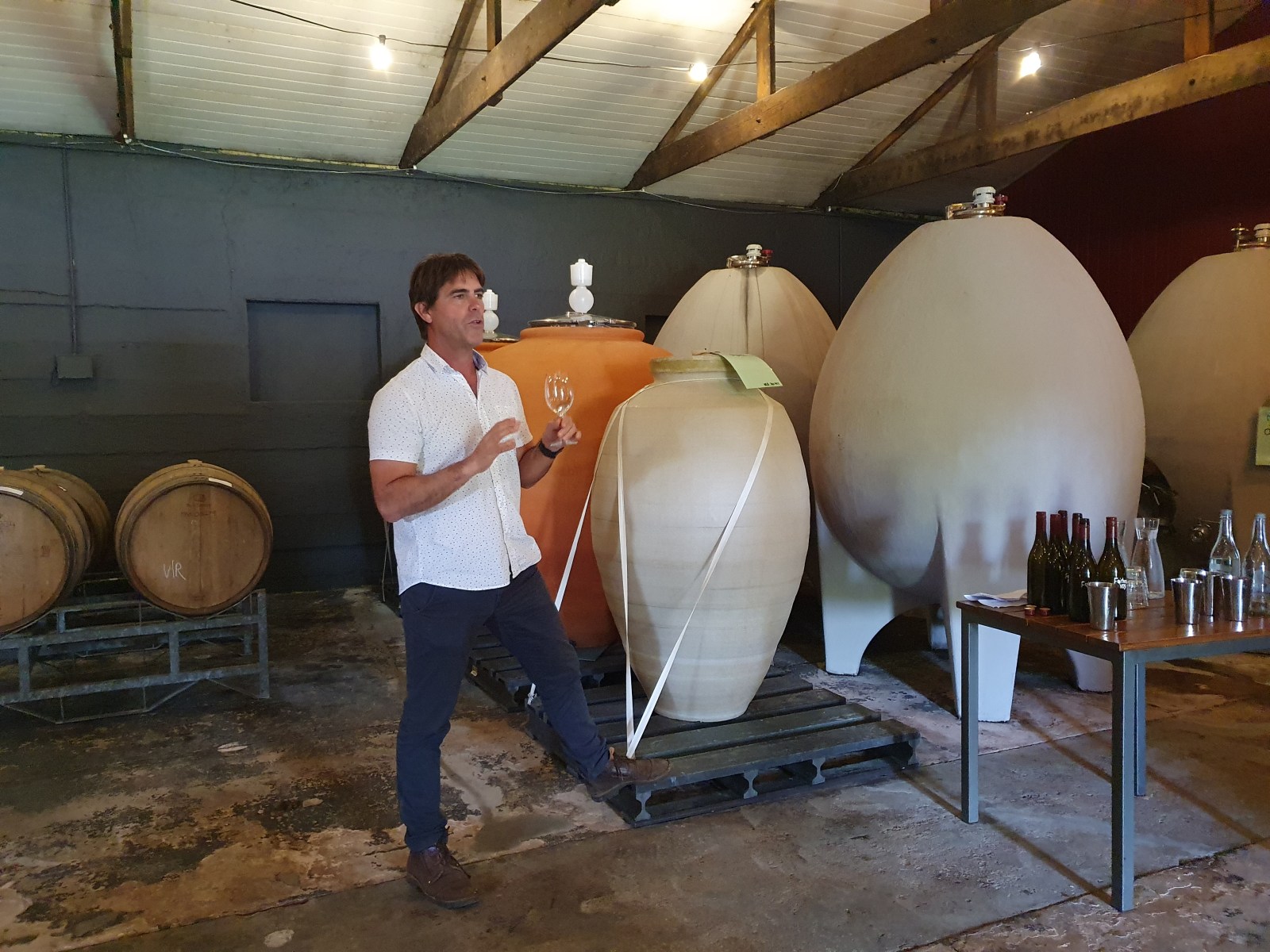
In the Joostenberg barrel cellar, winemaker Tyrrel Myburgh explains the different maturation properties he’s exploring in the concrete egg (right), ‘yogi’ clay amphora (centre) and old oak barrels. (Photo: Kit Heathcock)
For the Visser family at Dalewood, soil regeneration practices started off as a necessity. When Rob Visser was growing up his family farmed strawberries.
“I’d studied dairy technology and I always wanted to make cheese, but I never had the courage,” he says. “When I took over the farm from my dad, we were stuck with what he was doing, which was strawberries. We had a small dairy herd and we sold our milk to Fairview. My wife, Petrina, convinced me to make the switch, which we did in 2000. It was quite a big jump for us.”
Visser’s daughter Georgina takes up the tale.
“When we switched from strawberries to cheesemaking we had to start regenerating the soil for the pastures, restoring the natural balance, restoring the carbon cycle, the nutrient cycle, the water cycle, bringing biodiversity back to the land. We’ve done no spraying or fertilisers for 23 years. Over the last six years, we’ve really focussed on diversifying the plant species in our pastures with more than 14 species. Ryegrass, vetch, wild radish, turnips, lettuce… it’s a full-on salad for the cows.”
As the cows are eating more nutrient-dense foods, those nutrients go to the milk and the cheese, she says, giving the consumer a healthier product: “For your farmer, it’s creating an agricultural system that’s more sustainable, more resilient, more biodiverse.”
The cheese table has been sending out a siren call, all the time we’ve been listening, although the polite media bunch have somehow been able to restrain themselves from preemptively diving in. According to Georgina, cheese’s addictive quality is no myth, “Casein in cheese triggers the brain’s opioid receptors in a similar way to drugs,” she says. So that explains a lot.
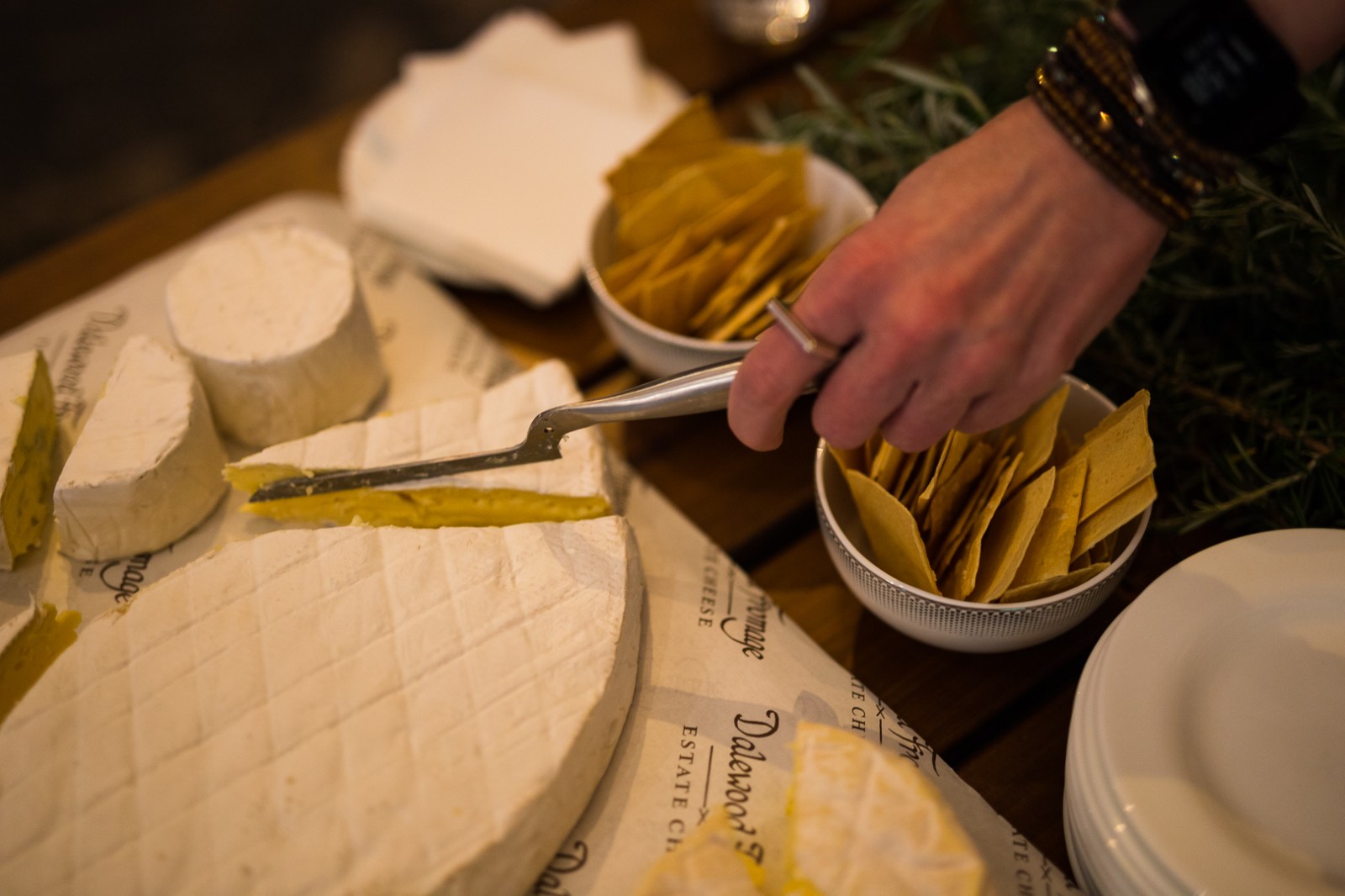
When cutting a Brie-style soft cheese the etiquette dictates you slice all the way from centre to edge. No sneaking extra chunks from the desirable oozy centre. (Photo: Ian du Toit)
Released from our restraint, we launch into cheese tasting, and the craft that has gone into their making is immediately apparent. A six-month-matured Boland, blue Camembert, French-style Brie Superlatif, the signature Dalewood Huguenot (aged for a whole year to mellow nuttiness and saved especially for this occasion), and the stunning washed-rind soft Lanquedoc — one of Rob Visser’s favourites — made with wild cultures in the rind, which results in a subtly herbal palette of flavours playing on the palate.
Luckily this is one mild addiction we don’t have to worry about, Georgina says: “When we think of fermented products we think kimchi, kombucha, kefir, we don’t think cheese. But raw unpasteurised cheese, especially aged cheeses, give a whole lot of benefits. It’s amazing for gut bacteria. Your absorption is enhanced, more able to absorb all those extra nutrients that come from cattle grazing on diverse natural pastures (antioxidants, omegas, essential fatty acids, vitamins K, E and A, beta-carotene). Now you can eat as much cheese as you want.”
Myburgh has meanwhile treated us to a parallel tasting of his 2023 vintage of the estate’s Fairhead white blend (all the white varieties on the farm including chenin blanc, viognier and Roussanne), which he’s experimenting with ageing in three different types of vessels: concrete eggs, a handmade 660-litre clay amphora made by Yogi de Beer in Hout Bay, and the more traditional old oak barrels. He’s fallen in love with the “yogi” and we can see why: bright pure fruit with just enough depth and a cheerful fresh acidity on the palate.
Between wine and cheese tasting, we’re lingering long in the barrel cellar, but a waft of spring blossom and the lure of the long flower-decorated table set on The Kraal’s stoep finally bring us to heel. At lunch, with a special menu designed around the Dalewood cheeses, the threads of all these stories are drawn together with a dash of kitchen alchemy from Tyrrel’s sister, Susan Dehosse, and chef Garth Bedford.
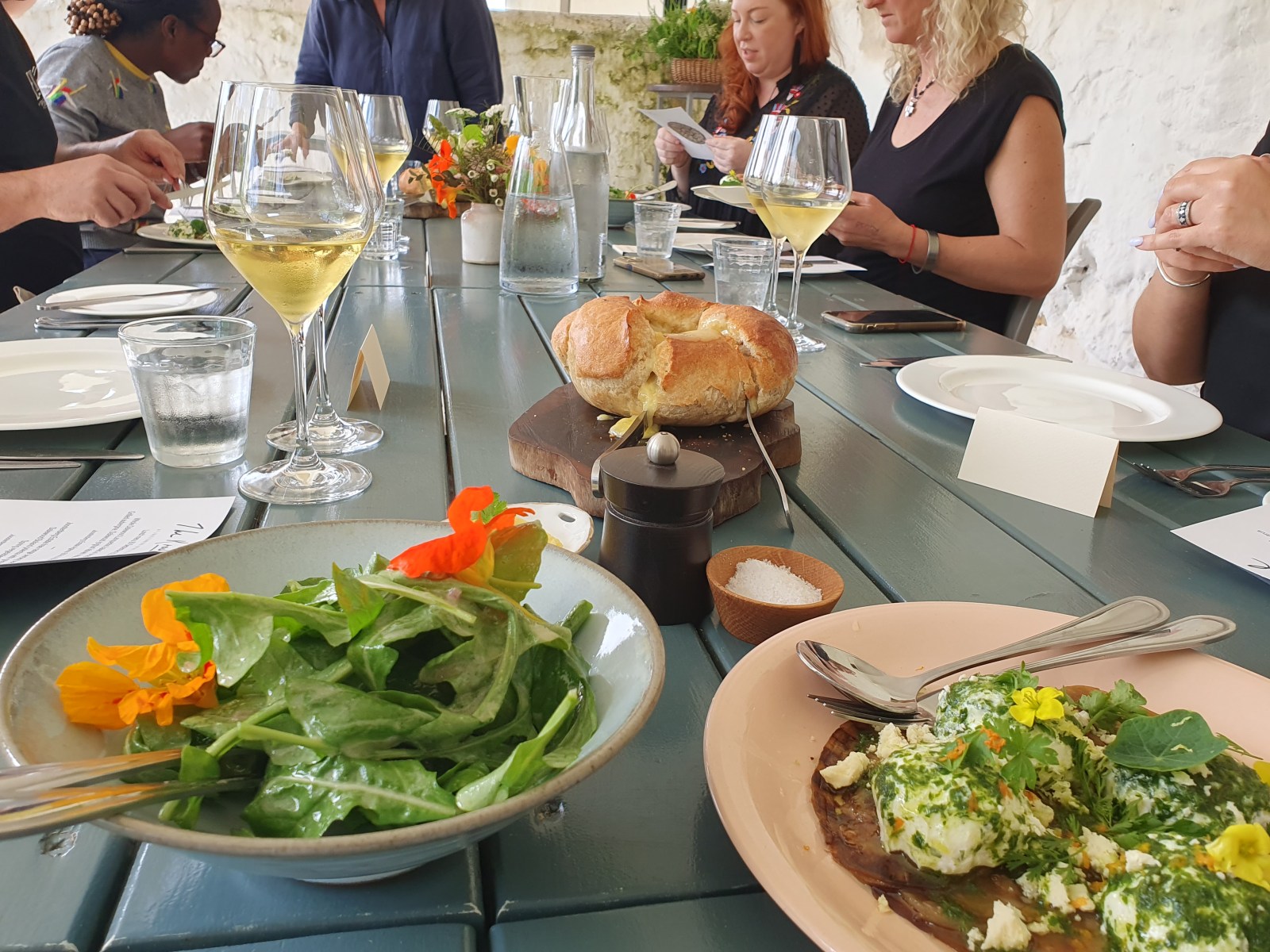
A long table lunch on the Kraal stoep kicks off with fresh and flavourful starters inspired by the Dalewood cheeses. (Photo: Kit Heathcock)
First up, a beautifully fresh labneh strained from the Dalewood yoghurt flecked with herbs and citrus on grilled aubergine. And a gorgeously decadent, entirely moreish whole Dalewood Lanquedoc cheese baked in bread, unctuously melting and fatally irresistible. Myburgh spoils us here with more treasures from the cellar: two vintages of sold-out Joostenberg Die Agteros Chenin Blanc, 2014 and 2022, from the oldest vineyard on the farm planted in 1982.
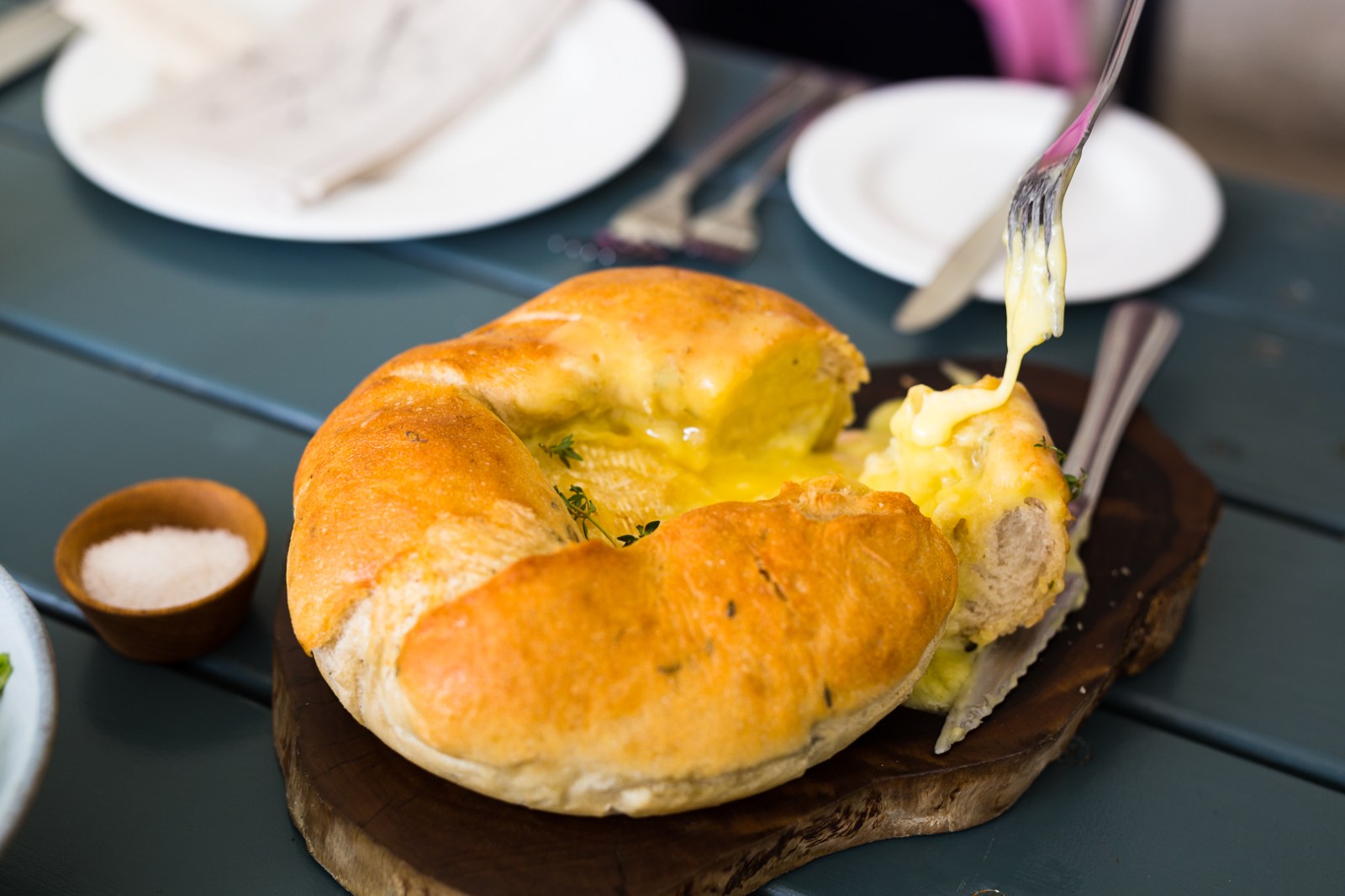
A whole Dalewood Lanquedoc soft cheese baked in bread to glorious melting decadence. (Photo: Ian du Toit)
Earlier in the morning that perennial thorny question of dairy farming was asked, “but what about the bull calves…”. Our main course illustrates sustainable farming symbiosis in action. A rich slow-cooked beef ragout is served on a lush polenta, yellow with maize meal from Bertie Coetzee at Lowerland Farm in Prieska, and enriched to lushness with Dalewood Boland cheese, and garnished in typical Joostenberg Kraal style with crunchy wild garlic flowers. Myburgh leans towards Visser indicating his plate and says, “Good meat…. who said Jersey cows don’t make good beef?”
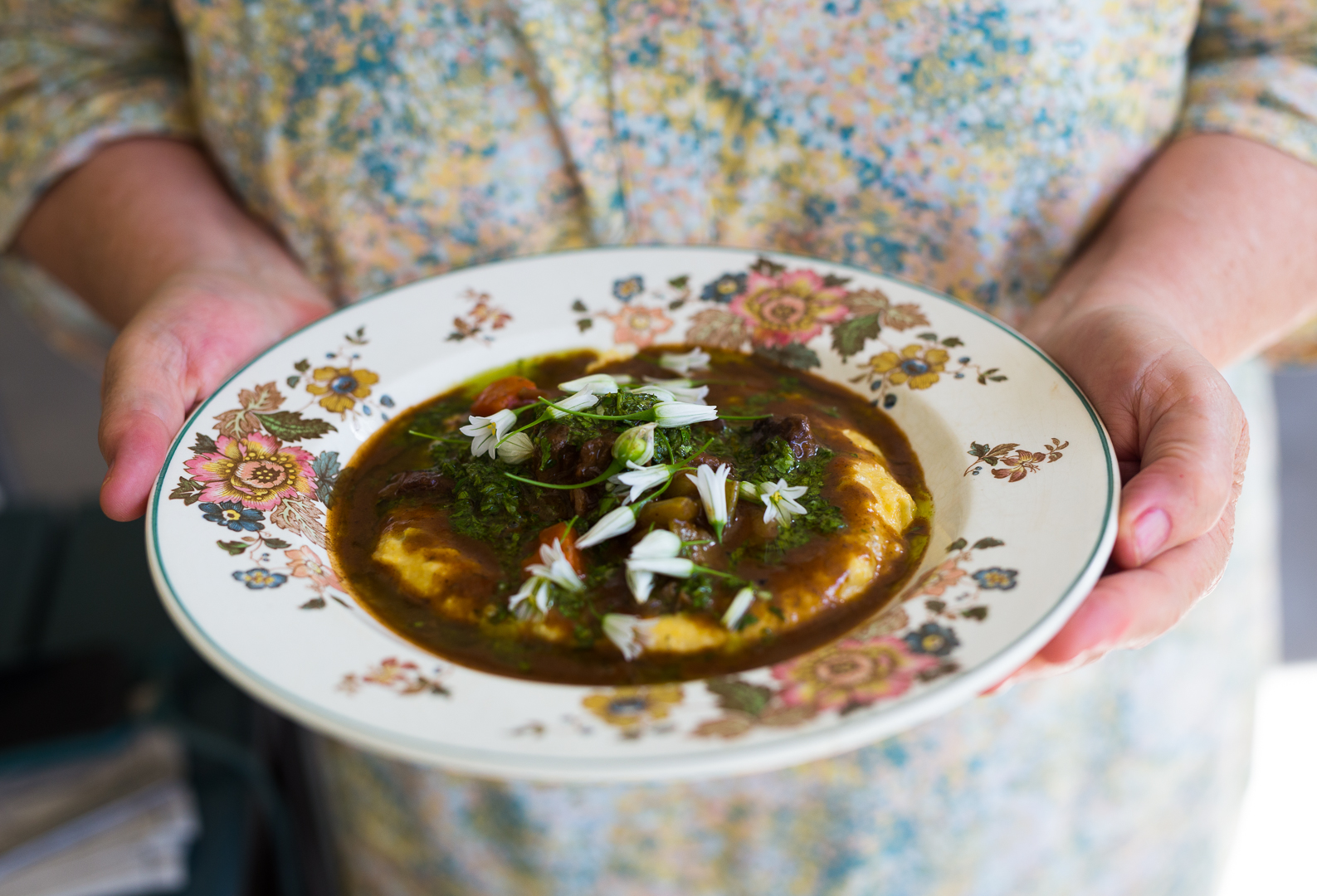
A rich Jersey beef ragout on polenta enriched with Dalewood Boland cheese and sprinkled with wild garlic flowers. The Kraal’s farm to table simplicity at its most delicious. (Photo: Ian du Toit)
Of course, we need an explanation after that. “We’ve been buying bull calves from Dalewood and using the calves to graze our vineyards,” Myburgh says. “Then they become part of our beef programme. It’s just a little sideline as part of sustainable farming. Sheep are easier in the vineyards, the biggest problem with cattle — if they’ve got an itch they’ll rub against a vine or a pole. But the quality of your cattle manure is higher than sheep. And if you graze more than one species then the parasites that end up in the soil from the manure compete against each other and you don’t get a build-up.
“So whenever Rob has, say, three bull calves, we’ll go over in a bakkie and pick them up.”
I learn something else new — apparently when you run sheep and cattle together you call it a flerd (from flock and herd,) as in my flerd is out grazing.
As we tuck into a salad of spiced poached pears with kale, Simond cheese and pecan nuts, Visser tells me more about the origins of Dalewood Fromage.
“I had the basics of dairy science from making cheese as a student. Then I travelled after university. I speak a bit of French so I spent time in France. I wasn’t copying, but I was definitely influenced by their cheeses. They have an enormous love for cheese and a beautiful range of cheese.”
He’s quick to emphasise that though they use the words ‘French-style’ to describe their Brie Superlatif, their cheeses are very much rooted in South African soil, with completely different flavours. It’s really only the size and shape that it has in common with its French cousin, but the familiar name in those early days helped a new breed of cheese-lover to connect.
“Back then SA was very mono-cheese, blocks of Cheddar and Gouda and that was it. From 2000 artisanal cheeses were taking off. The timing was great, people were interested in new cheeses, becoming more adventurous.”
Dalewood has 250 Jersey cows in total, but it’s a closed herd, meaning they are raising all their own heifers.
“So we’ve got followers and dry cows. Generally, there are about 120 getting milked daily, more or less. We’re minuscule compared to others,” Rob Visser says.
We take the opportunity to ask him for some expert advice on getting our cheeses to the perfect point before eating: “A lot of people get the ripening of the cheese wrong. It depends very much on the temperature of your fridge. To speed up ripening take it up to 10 degrees. The best way to judge ripeness of a Camembert: just squeeze it. It’s ripe when it feels soft. You’ll see French shoppers are always squeezing the cheese, you’re not ‘supposed’ to but that’s the quickest way to tell.
“You’ve only really got a perfect week with a Camembert,” he continues. “A Dalewood Lanquedoc has a longer space. We give it a shelf life of five weeks. If the temperature of the fridge is all right, the perfect week to eat the cheese is week four, so a week before the expiry date.”
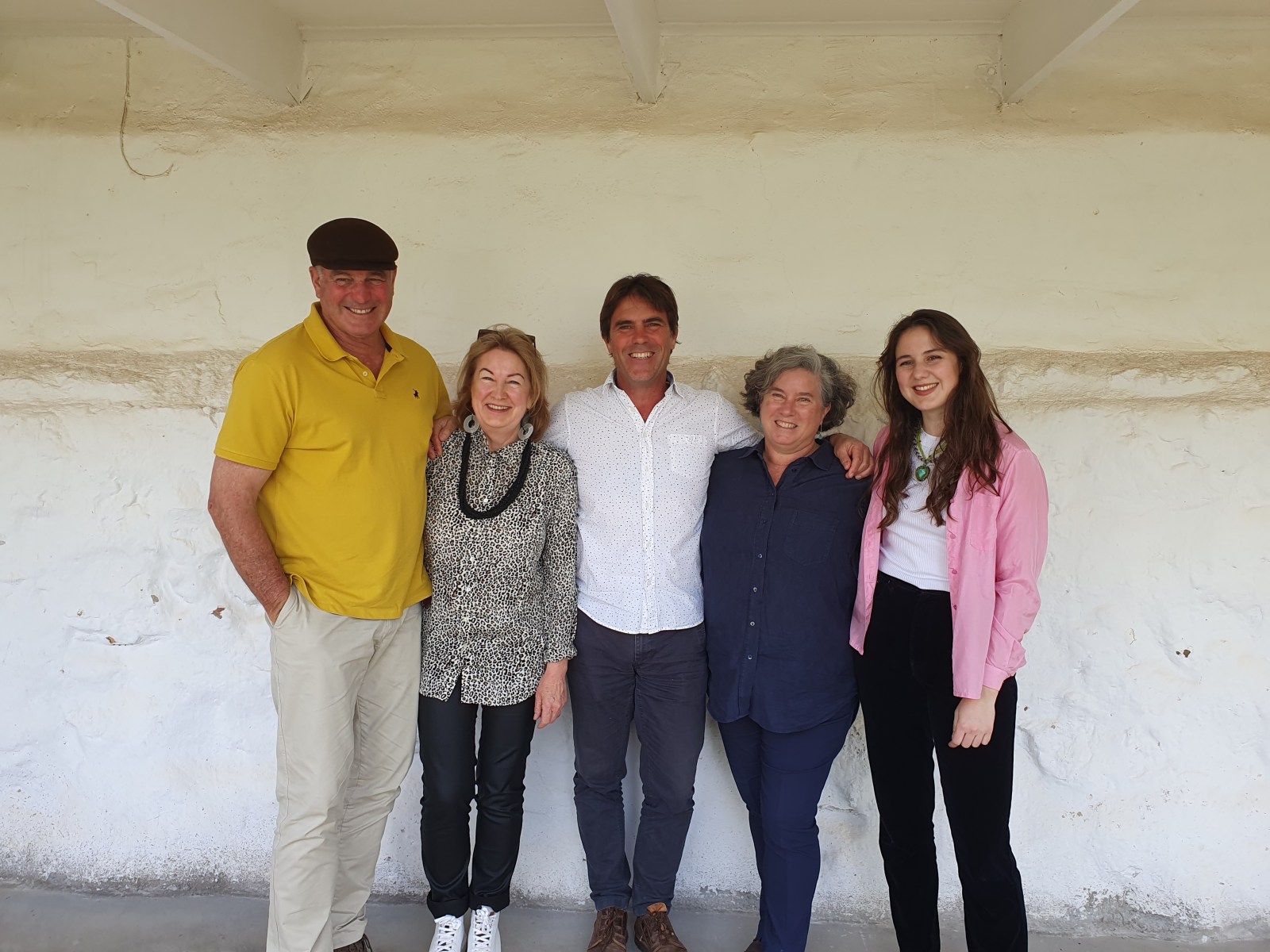
The Dalewood and Joostenberg families come together at The Kraal: (L to R) Rob Visser, Petrina Visser, Tyrrel Myburgh, Susan Dehosse, Georgina Visser. (Photo: Kit Heathcock)
Bringing it up to room temperature is crucial, he says. The flavour changes, the cheese softens to the perfect mouth feel. The perfect temperature for a soft cheese is probably about 17 degrees. And for hard cheese 15 degrees, to allow the flavours to develop.
Dessert is arriving now and Susan Dehosse weaves some of the shared history between the two family farms into its story.
“When we started in the restaurant business we always bought our strawberries from Dalewood,” she says. “When Petrina became involved and the farm changed to cheesemaking in 2000, we were quite devastated when we couldn’t get their strawberries any more, but they referred us to another Klapmuts farm, and we still source from that farm today.”
So we savour strawberries served with a Chantilly using Dalewood’s crème fraiche, and a Dalewood buttermilk and strawberry ice cream. There’s meringue studded with fennel seeds, and shreds of fresh fennel leaves and mint, for a beautifully spring-themed freshness. And two vintages (2015 and 2021) of Joostenberg Chenin Blanc Noble Late Harvest.
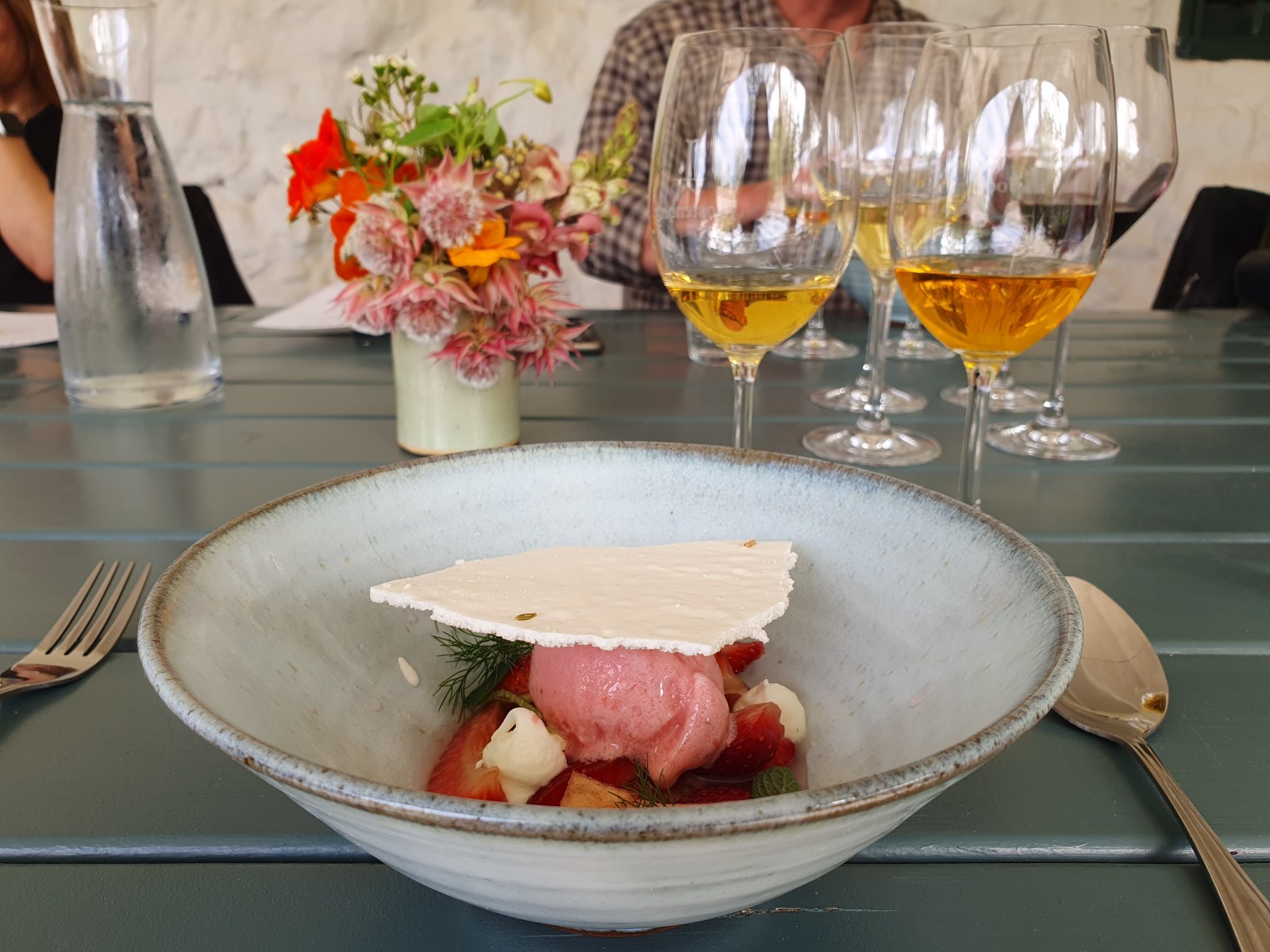
A strawberry dessert telling the story of the long collaboration between Dalewood and Joostenberg family farms. Paired with two vintages of Joostenberg’s Noble Late Harvest chenin blanc. (Photo: Kit Heathcock)
One last common theme linking the two neighbouring family farms is that they are both focusing on single-origin products. The time invested in building the soil is a commitment to the future, and a belief that healthy soil and land makes for a better product.
“I’m trying to get the best expression of this little patch of dirt in the glass over time,” says Myburgh. “Every year I’m looking at the same vineyards, the same soil, and I’m trying to make small improvements as I go along. Hopefully, one of these days I’m going to produce the holy grail of wine… or at least one of my great-great-grandchildren will. It’s a multi-generational thing.” DM
For more information about Dalewood Fromage, visit www.dalewood.co.za.
For more information about Joostenberg and The Kraal Restaurant, visit joostenberg.co.za.
Follow Kit Heathcock on Instagram @kitheathcock.





Comments - Please login in order to comment.